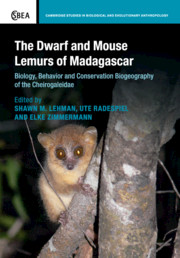 The Dwarf and Mouse Lemurs of Madagascar
The Dwarf and Mouse Lemurs of Madagascar Book contents
- Frontmatter
- Contents
- List of contributors
- Foreword
- Part I Cheirogaleidae: evolution, taxonomy, and genetics
- Part II Methods for studying captive and wild cheirogaleids
- Part III Cheirogaleidae: behavior and ecology
- Part IV Cheirogaleidae: sensory ecology, communication, and cognition
- 18 Seed dispersal by mouse lemurs: do Microcebus represent a unique frugivorous guild?
- 19 Predation in the dark: antipredator strategies of Cheirogaleidae and other nocturnal primates
- 20 The gray mouse lemur (Microcebus murinus): a novel cognitive primate brain aging model
- 21 Acoustic divergence in communication of cheirogaleids with special emphasis to mouse lemurs
- 22 Modeling the origins of primate sociality: social fl exibility and kinship in mouse lemurs (Microcebus spp.)
- Part V Cheirogaleidae: conservation biogeography
- Index
- Plate section
- References
19 - Predation in the dark: antipredator strategies of Cheirogaleidae and other nocturnal primates
from Part IV - Cheirogaleidae: sensory ecology, communication, and cognition
Published online by Cambridge University Press: 05 March 2016
- Frontmatter
- Contents
- List of contributors
- Foreword
- Part I Cheirogaleidae: evolution, taxonomy, and genetics
- Part II Methods for studying captive and wild cheirogaleids
- Part III Cheirogaleidae: behavior and ecology
- Part IV Cheirogaleidae: sensory ecology, communication, and cognition
- 18 Seed dispersal by mouse lemurs: do Microcebus represent a unique frugivorous guild?
- 19 Predation in the dark: antipredator strategies of Cheirogaleidae and other nocturnal primates
- 20 The gray mouse lemur (Microcebus murinus): a novel cognitive primate brain aging model
- 21 Acoustic divergence in communication of cheirogaleids with special emphasis to mouse lemurs
- 22 Modeling the origins of primate sociality: social fl exibility and kinship in mouse lemurs (Microcebus spp.)
- Part V Cheirogaleidae: conservation biogeography
- Index
- Plate section
- References
Summary
Introduction
Predation can incur extreme fitness costs and can therefore drive the evolution and maintenance of elaborate and costly antipredator behavior in prey species (Caro, 2005; Fichtel, 2012). Although about one-third of all primates are nocturnal, small-bodied, and presumably facing a high predation risk (van Noordwijk et al., 1993; Isbell, 1994; Janson, 2003; Hart, 2007; Scheumann et al., 2007), few data exist regarding their alarm-calling behavior and other antipredator strategies (Fichtel, 2012). In general, predation occurs quickly, is rarely observed, and is difficult to study; even more so in nocturnal primates due to poor visibility at night. Small body size and nocturnality have been suggested to represent adaptations to reduce predation risk (Clutton-Brock and Harvey, 1977). Accordingly, nocturnal and diurnal species have been suggested to differ in their antipredator strategies; whereas nocturnal species may depend on reduced detectability and crypsis, diurnal species rely on early detection to ward off predators (Terborgh and Janson, 1986). However, recent studies revealed that not all nocturnal primates necessarily rely on reduced detectability and crypsis; some also mob predators and appear to rely on a combination of alarm calls and escape responses that are adapted to the different hunting tactics of predators (Fichtel, 2012).
Because little is known about antipredator behavior in cheirogaleids, in this chapter I will first summarize the current knowledge on antipredator behavior in nocturnal primates and then portray what is known about antipredator behavior in cheirogaleids. I begin with summarizing the kind of animals that prey upon cheirogaleids and which cues nocturnal primates use to recognize predators. Because predation imposes direct costs of mortality and chronic indirect costs of employing behaviors that reduce mortality risk, antipredator behavior can be broadly classified into tactics used to avoid encountering predators and those employed after predator detection (Stanford, 2002). Therefore, I will secondly summarize tactics taken before encountering predators such as predator-sensitive foraging, appropriate sleeping site selection, increased vigilance, and the formation of mixed-species associations. Thirdly, I will address tactics that take effect during encounters such as alarm-calling and mobbing as well as various escape and defense tactics. Moreover, I will briefly discuss the evolution of grouping effects. Finally, I conclude this chapter by discussing future aspects of research on antipredator behavior in nocturnal primates.
- Type
- Chapter
- Information
- The Dwarf and Mouse Lemurs of MadagascarBiology, Behavior and Conservation Biogeography of the Cheirogaleidae, pp. 366 - 380Publisher: Cambridge University PressPrint publication year: 2016
References
- 8
- Cited by
